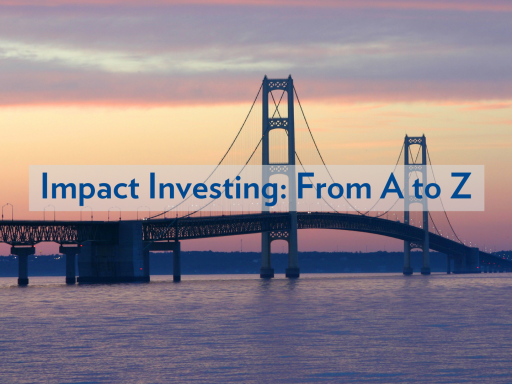For Every Investment, an Impact
Impact investments are made with the intention to generate positive, measurable social and environmental impact alongside financial return.
Impact investments are made with the intention to generate positive, measurable social and environmental impact alongside financial return.

By Jennifer Oertel, CMF Impact Investing Expert in Residence
The definition of impact investing used by CMF, and many practitioners in our sector, comes from the Global Impact Investing Network (GIIN): “Impact investments are investments made with the intention to generate positive, measurable social and environmental impact alongside a financial return.” Most agree that such investments may be made into both emerging and developed markets, and they may target a range of returns from below-market to market rate, depending on the investors' goals.
Some prefer the terms “social investing”, “mission-related investing” or “mission-aligned” investing. In a May 2019 edition of “Philanthropy Perspectives” in CMF’s Weekly Download we discuss the need to get beyond the name so that whether you call it “impact investing” or otherwise, we focus on the underlying premise: Foundations can actively seek out investments whose product offering or way of doing business is intended to create a positive social impact.
Whether your foundation is actively seeking such investments or not, this is the challenge question I presented to funders in the “Perspectives” piece: Is it enough to deploy 5 percent of your foundation’s assets toward your charitable mission while the “other 95 percent” is in investments, their impact unknown to you? It is possible that your investments may actually be creating the harm that your mission aims to solve.
Your investments have an impact on society and the environment, whether that impact is intentional or not, whether positive or negative.
More and more organizations are putting all of their investment assets into what they deem socially impactful investments. In this day and age, it is possible to have a fully diversified portfolio that is entirely invested for intentional positive impact. While going “all in” for impact is not as simple as doing things the way they’ve always been done, foundation leaders know that nothing worth doing is easy.
Environmental, social and governance (ESG) screens have been around longer than the term impact investing. This screening involves the review of the environmental and social impact of particular companies, how they do business and the fairness of their corporate governance. Some utilize negative screens to weed out what they deem to be “sin stocks” (e.g., liquor, tobacco, gambling, guns) or fossil fuels. Others have moved beyond that, from screening out to seeking out – searching for companies they deem to have positive societal impact given their products or business methods. Groups also utilize “shareholder activism” by acquiring the requisite amount of equity, typically in public companies, in order to present shareholder proposals aimed at influencing corporate behavior. (I am always reminded of the fact that large law firms didn’t really start hiring female corporate attorneys like myself or otherwise pay much attention to any other form of diversity until their clients demanded it.) If you search online for the term “ESG stock screener” you will find a plethora of tools to aide in screening stocks. Most investment advisors also have the tools to assist in screening.
Any activity to more proactively review your investments – to “own what you own” – is to be lauded and encouraged, but in my opinion impact investing goes a step further because it involves actively seeking out investments that create a positive social impact.
Here are some relatively simple ways to get started:
Deposits in Community Development Financial Institutions (CDFIs) or other community banks that loan your funds to those who have difficulty getting funding from traditional banks.
Investing in funds or “funds of funds” that make impact investments that fit your definition.
Investments in publicly traded fixed income securities that will be deployed in the impact theme or zip code you designate. (The Michigan Collaborative is one such example.)
Impact investing can also be more involved and direct:
Using your balance sheet to help de-risk a loan through a guarantee (or deposit account).
Directly making loans.
Operating revolving loan funds.
Funding pay for success programs.
Making direct equity investments.
You can further support impact investing through grants for technical assistance or supporting intermediaries that assist social entrepreneurs or educate investors. We’ll explore more examples in depth in later blogs.
Just like beauty is in the eye of the beholder, I believe the meaning and practice of impact investing is at the discretion of the investor. By whatever name or definition, any small steps toward taking a more active approach to managing the positive and negative societal effects of your investments is a good thing.
Agree? Disagree? Have a story to share? Please reach out!